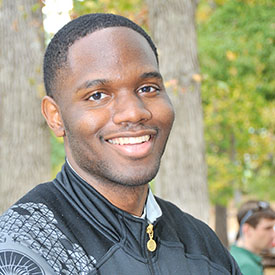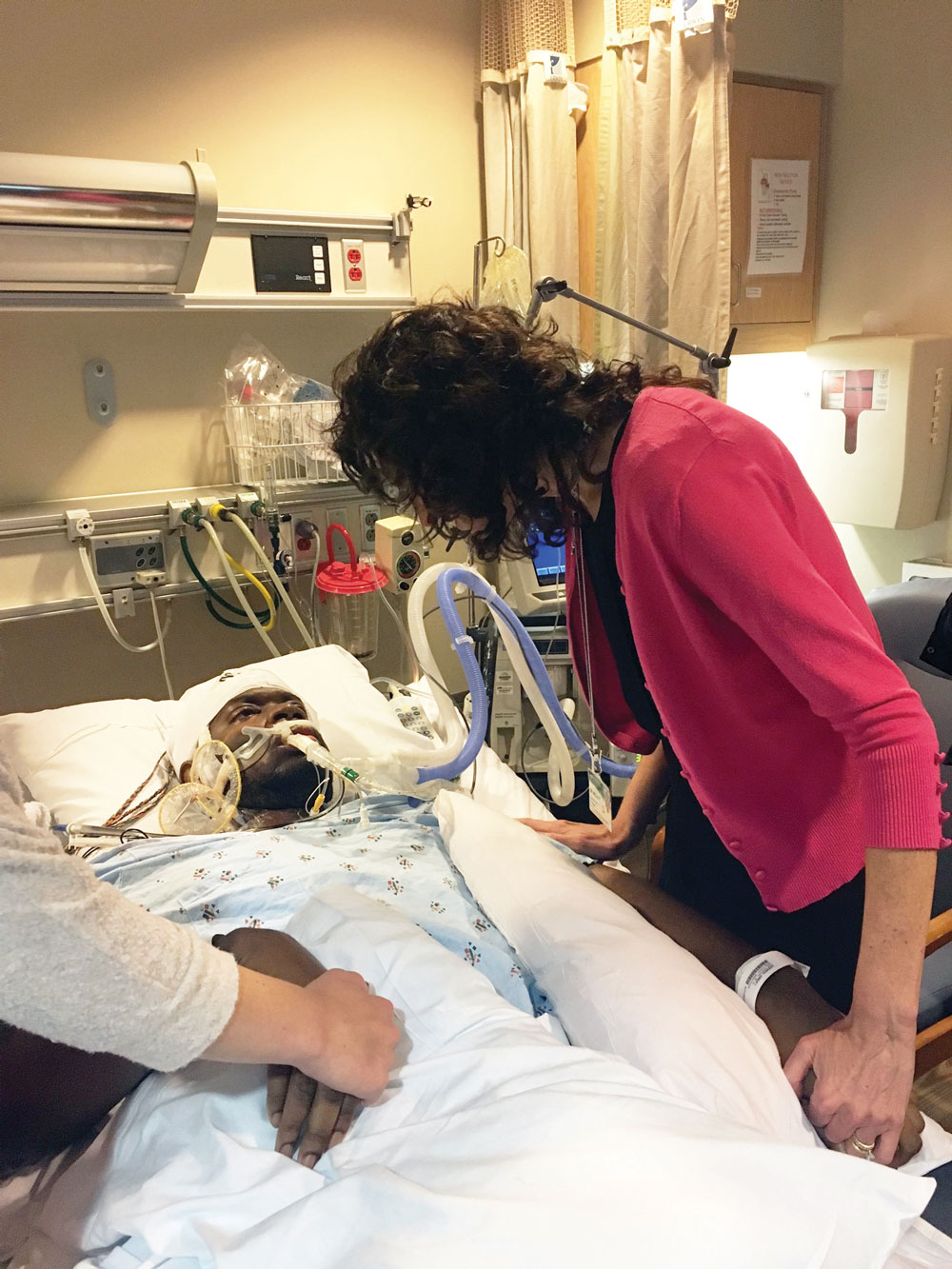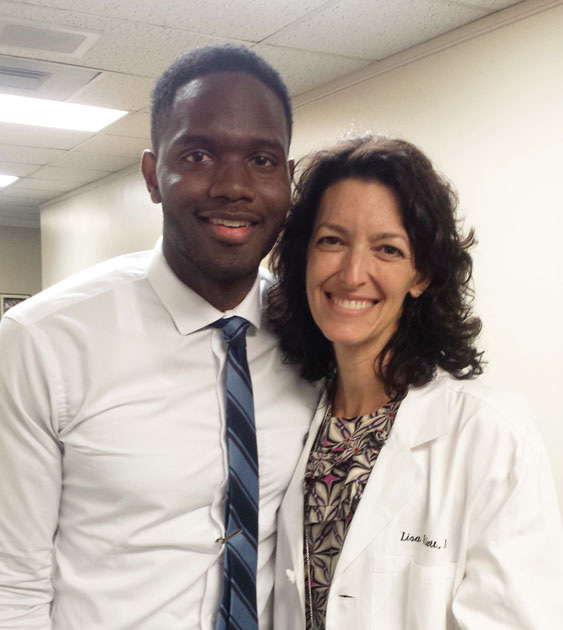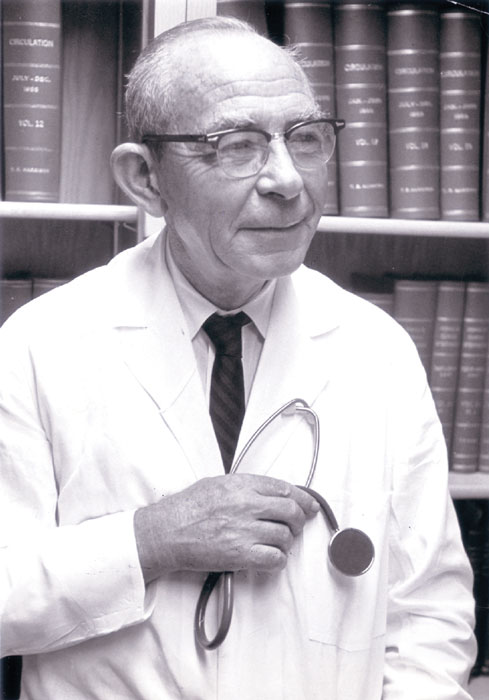 As a third-year internal medicine resident, Anezi Uzendu survived a severe cardiac arrest, thanks in part to his residency family.On November 28, 2016, Anezi Uzendu, M.D., a third-year resident in the Tinsley Harrison Internal Medicine Residency Program, was playing basketball at a local gym when he went into cardiac arrest and passed out from a loss of blood flow to the brain. A local chiropractor who happened to be in the gym came to Uzendu’s aid and performed CPR until paramedics arrived. Uzendu was shocked more than 10 times with a defibrillator, and he didn’t regain consciousness until a week later.
As a third-year internal medicine resident, Anezi Uzendu survived a severe cardiac arrest, thanks in part to his residency family.On November 28, 2016, Anezi Uzendu, M.D., a third-year resident in the Tinsley Harrison Internal Medicine Residency Program, was playing basketball at a local gym when he went into cardiac arrest and passed out from a loss of blood flow to the brain. A local chiropractor who happened to be in the gym came to Uzendu’s aid and performed CPR until paramedics arrived. Uzendu was shocked more than 10 times with a defibrillator, and he didn’t regain consciousness until a week later.
“People don’t survive what I survived,” Uzendu says. “I didn’t know the people at the gym, but they did a great job of stabilizing me until I could get to the hospital. I know I was intubated and placed under hypothermia protocol once I was admitted.”
After being taken to a nearby hospital, Uzendu was put into a medically induced coma as part of the hypothermia protocol. With no medical or family history of heart disease, he was diagnosed with ventricular fibrillation, the most serious cardiac rhythm disturbance, where his lower chambers quivered and his heart couldn’t pump blood. He says he never regained his memory from that day.
“After I awoke from the medically induced coma, I was in the CCU [Cardiac Care Unit at UAB Hospital] and had memory issues,” he recalls. “I was surrounded by friends and family, and they helped me piece my life together.”
 Uzendu was a patient in the same Cardiac Care Unit at UAB that he worked in as a resident.Uzendu says UAB Internal Medicine Residency Program Director Lisa Willett, M.D., was instrumental in reassuring his family that he would get the best possible care. She helped get him transferred to UAB Hospital when he was deemed stable enough to transport, and he was admitted to the CCU while still in the medically induced coma.
Uzendu was a patient in the same Cardiac Care Unit at UAB that he worked in as a resident.Uzendu says UAB Internal Medicine Residency Program Director Lisa Willett, M.D., was instrumental in reassuring his family that he would get the best possible care. She helped get him transferred to UAB Hospital when he was deemed stable enough to transport, and he was admitted to the CCU while still in the medically induced coma.
“After he was transferred to UAB and I spoke with the cardiologists, they told me he had less than a 10 percent chance of surviving this,” says Willett. “He had complete, multisystem failure, so almost every organ in his body was not working.”
“Dr. Willett was really instrumental in taking care of everything while my parents were coming from St. Louis,” Uzendu says. “She and all the chief residents came to see me at the hospital and helped me get transferred to UAB. They could tell that I really didn’t look well, and they wanted me to receive the best possible care, which was at UAB.”
Uzendu, who began a cardiology fellowship at The Ohio State University this summer, was accustomed to seeing patients in the CCU, but he never imagined he would become one. “I was in the same CCU that I’m used to working in, and I had great nurses and doctors that I worked with all the time as a colleague now taking care of me as a patient.”
Just six weeks after the event that left him clinging to life, Uzendu was cleared by his doctors to return to work and was back seeing patients on his normal rotation schedule. “I think one of the coolest things to come out of this experience is the love and overwhelming support that was shown to me while I was in the hospital from my family to the staff and fellow residents,” he says. “There were so many people offering help, whether it was covering shifts or bringing my parents food.
“They also had a prayer service for me in the chapel at UAB,” Uzendu elaborates. “I later found out there were multiple prayer chains set up for me. In addition to the amazing care I received at UAB, I believe my life was saved thanks to a powerful God who answered those prayers.”
Forever Family
 Uzendu and Tinsley Harrison Internal Medicine Residency Director Lisa Willett share a special bond.UAB School of Medicine residents undergo rigorous training and are prepared for practice the moment they complete their programs. Residents experience the highs and lows of practicing medicine together, and that camaraderie often translates into intense bonds and long-lasting friendships. But what happens when the resident becomes the patient?
Uzendu and Tinsley Harrison Internal Medicine Residency Director Lisa Willett share a special bond.UAB School of Medicine residents undergo rigorous training and are prepared for practice the moment they complete their programs. Residents experience the highs and lows of practicing medicine together, and that camaraderie often translates into intense bonds and long-lasting friendships. But what happens when the resident becomes the patient?
Willett says seeing one of her trainees in such a seemingly hopeless state was unforgettable, but so was her relief when Uzendu began to show signs of improvement. “Someone was always with him while he was in the CCU,” she says. “You can imagine the excitement and celebration in the CCU the first time he squeezed our hand and we knew he was responding.”
Uzendu says the experience has given him a unique perspective on his chosen profession. “I know that there was a lot of good that came from my illness,” he says. “I think one of the main things for me is to know how to empathize better with my patients. When you haven’t gone through it, it’s a little harder to know what patients go through. It was an important time of growth for me physically, spiritually, and career-wise.”
Uzendu says when he was accepted to the Tinsley Harrison Residency Program, he expected to receive an outstanding training experience, but he left with something equally as valuable.
“I knew there was collegiality at UAB, but I never knew there would be a family environment like I experienced during my time there,” he says. “When I came there, I didn’t know anyone, but I feel like I left with a whole new family.” By Adam Pope
Honoring Our History
|
 The Tinsley Harrison Internal Medicine Residency Program is named for one of UAB’s most distinguished faculty leaders, Tinsley Harrison, M.D. Founding editor and editor in chief of the first five editions of Harrison’s Principles of Internal Medicine, Harrison was born in Talladega, Alabama, in 1900 to a long line of physicians. He completed his medical training at The Johns Hopkins University School of Medicine, Peter Bent Brigham Hospital in Boston, and Vanderbilt University Medical Center. He later became acting dean of the Medical College of Alabama (now UAB) and chair of the Department of Medicine in 1950. Harrison helped initiate a period of rapid growth at UAB that included recruiting nationally known physicians from the faculties of Harvard University and the Mayo Clinic, among others. This period also saw UAB rise from local to international prominence. In addition to the internal medicine residency program, the Tinsley Harrison Research Tower on UAB’s campus is named to honor the man who famously said, “No greater opportunity, responsibility, or obligation can fall to the lot of a human being than to become a physician.”
The Tinsley Harrison Internal Medicine Residency Program is named for one of UAB’s most distinguished faculty leaders, Tinsley Harrison, M.D. Founding editor and editor in chief of the first five editions of Harrison’s Principles of Internal Medicine, Harrison was born in Talladega, Alabama, in 1900 to a long line of physicians. He completed his medical training at The Johns Hopkins University School of Medicine, Peter Bent Brigham Hospital in Boston, and Vanderbilt University Medical Center. He later became acting dean of the Medical College of Alabama (now UAB) and chair of the Department of Medicine in 1950. Harrison helped initiate a period of rapid growth at UAB that included recruiting nationally known physicians from the faculties of Harvard University and the Mayo Clinic, among others. This period also saw UAB rise from local to international prominence. In addition to the internal medicine residency program, the Tinsley Harrison Research Tower on UAB’s campus is named to honor the man who famously said, “No greater opportunity, responsibility, or obligation can fall to the lot of a human being than to become a physician.”